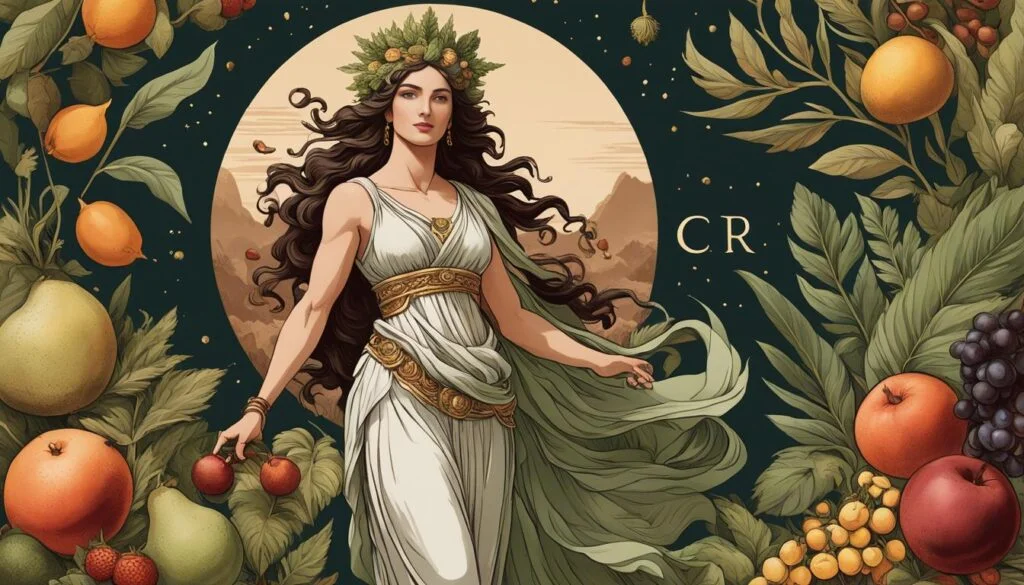Welcome to a fascinating journey into the world of Greek and Roman mythology, where powerful gods and goddesses hold sway over the forces of nature and human existence. In this article, we unravel the enigmatic figure of Ceres, a goddess deeply intertwined with the domains of grain, agriculture, and fertility.
In Greek mythology, Ceres is revered as the Earth Mother, the goddess responsible for nurturing humankind through her control over crops and harvests. Known for her bountiful abundance and life-giving powers, Ceres holds a significant place in the pantheon of ancient deities.
Key Takeaways:
- Ceres is a prominent figure in Greek and Roman mythology, considered as the goddess of grain, agriculture, and fertility.
- She is known as the Earth Mother, symbolizing nourishment and sustenance for humankind.
- Ceres’ story is deeply intertwined with the abduction of her daughter Persephone by Hades, the god of the underworld, resulting in the changing seasons.
- In art and symbolism, Ceres is often depicted as a noble figure, crowned with wheat ears and carrying symbols of abundance.
- The worship of Ceres is celebrated through festivals such as the Cerealia in Rome and the Eleusinian Mysteries in Greece.
The Story of Ceres in Greek Mythology
According to Greek mythology, Ceres, also known as Demeter, is the daughter of Cronus and Rhea. She is the sister of Zeus and other major gods. One of the most well-known stories involving Ceres is the abduction of her daughter Persephone by Hades, the god of the underworld.
Distraught by her daughter’s disappearance, Ceres neglects her duties as the goddess of agriculture, causing a famine on Earth. Eventually, Persephone is allowed to spend part of the year with Ceres on Earth, which explains the changing seasons.
The Abduction and the Changing Seasons
- Ceres, the goddess of grain and agriculture
- Abduction of her daughter Persephone by Hades
- Distress leads to neglect of agricultural duties
- Famine and struggle on Earth
- Persephone’s return brings spring and fertility
Ceres in Roman Mythology

In Roman mythology, Ceres is worshipped as the goddess of agriculture and abundance. She holds a prominent place in the pantheon and is often depicted as a matronly figure, crowned with wheat ears and carrying a sickle or cornucopia.
Ceres possesses formidable powers and abilities. She has the ability to bring forth bountiful harvests, ensuring the prosperity of crops and the fertility of the earth. As the guardian of agriculture, she oversees the growth and abundance of food, sustaining human life. However, Ceres is not to be trifled with, as she has the power to bring blight and famine upon the land if angered.
Ceres is closely associated with the seasons, reflecting the cyclical nature of life, death, and rebirth. Her influence is intertwined with the rhythm of the natural world, as the changing seasons mark the transitions in agricultural cycles and the ebb and flow of life.
Key Powers and Abilities of Ceres:
- Control over agricultural fertility and abundance
- Ability to bring forth bountiful harvests
- Potential to cause blight and famine when angered
- Association with the seasons and the cycle of life, death, and rebirth
Ceres’ significance in Roman mythology and her role as the goddess of agriculture highlight the deep-rooted connection between humanity and the cultivation of crops. Her powers and abilities demonstrate the importance of maintaining a harmonious relationship with the natural world to ensure the sustenance and prosperity of civilization.
The Cult of Ceres and Her Festivals

The worship of Ceres held great significance in both ancient Greece and Rome. These ancient civilizations celebrated the goddess of grain and agriculture through various vibrant festivals and rituals that emphasized the importance of bountiful harvests and agricultural prosperity.
In Rome, one of the most prominent festivals dedicated to Ceres was the Cerealia. This annual celebration involved women dressed in white garments, carrying torches as they symbolically searched for Ceres’ abducted daughter, Persephone. The Cerealia festival aimed to honor Ceres’ role as a mother figure and to invoke her blessings for fertility and abundant crops.
On the other hand, in Greece, the worship of Ceres was intricately connected to the Eleusinian Mysteries. These were secret rituals held in the city of Eleusis, dedicated to Ceres and Persephone. The Eleusinian Mysteries celebrated the cycle of life, death, and rebirth, embodying the agricultural seasons and the eternal rhythms of nature.
These mysterious and sacred rituals were kept strictly confidential, and only those initiated into the cult of Ceres were allowed to participate. The rituals were believed to bring about spiritual enlightenment and a deeper understanding of the divine mysteries associated with the goddess and the agricultural cycle.
The Cerealia Festival
The Cerealia festival was an important event in Roman society, highlighting the reverence for Ceres and the vital role she played in ensuring agricultural abundance. Women adorned in white attire would gather in the streets of Rome, carrying torches and offering prayers and sacrifices to the goddess. These processions symbolized the search for Ceres’ daughter, Persephone, and her eventual return, representing the restoration of the fruitful seasons.
The Eleusinian Mysteries
The Eleusinian Mysteries in Greece were highly exclusive rituals held annually in Eleusis, near Athens. These ceremonies were open only to the initiated and aimed to deepen the participants’ connection with Ceres and Persephone, granting them spiritual insight and enlightenment.
The exact details of the Eleusinian Mysteries remain shrouded in secrecy, as all initiates took an oath of silence, forbidding them from revealing the inner workings of the rituals. However, it is believed that these ceremonies involved dramatic performances, symbolic sacrifices, and sacred processions that immersed participants in the powerful symbolism of life, death, and rebirth.
The Ceres cult and its associated festivals, such as the Cerealia in Rome and the Eleusinian Mysteries in Greece, exemplified the importance of agricultural prosperity in ancient societies. These celebrations served as a way to honor and appease Ceres, ensuring the fertility of the land and the abundance of harvests, which were essential for the sustenance and well-being of the people.
Ceres’ Influence in Art and Symbolism

Ceres, the goddess of grain and agriculture, has left an indelible mark on the world of art and symbolism. In countless artworks, she is portrayed as a noble and majestic figure, exuding grace and power. Artists throughout history have captured her essence, creating stunning depictions that celebrate her role as the Earth Mother.
When represented in art, Ceres is often adorned with a crown of wheat ears, symbolizing her association with agriculture and the abundance of harvests. This distinctive crown serves as a visual tribute to her essential role in providing sustenance to humanity.
In addition to the wheat crown, Ceres is commonly depicted carrying symbolic objects that further emphasize her connection to nature’s cycles. The sickle, a tool used in harvesting crops, is a frequent attribute accompanying her image. It represents her role in overseeing the cultivation and reaping of bountiful harvests.
Shafts of grain, representing the crops that flourish under her watchful care, are another common feature in Ceres’ iconography. These symbols highlight her power to bring forth abundance and ensure the prosperity of agricultural endeavors.
Furthermore, Ceres is often shown with a cornucopia, a horn-shaped vessel overflowing with fruits, vegetables, and grains. This symbol of abundance pays homage to her ability to provide ample resources to sustain life.
In Roman mythology, Ceres is credited with the discovery of agriculture and the cultivation of crops. It is no wonder, then, that her imagery and symbolism continue to inspire artists today, serving as a reminder of the vital importance of agriculture in society.
Ceres and Modern Culture

Ceres’ influence goes beyond ancient mythology and continues to resonate in modern culture. Her name has even left a lasting mark on our everyday language. The English word “cereal” derives from Ceres, signifying the vital role grain crops play in sustaining human life.
In the realm of literature, Ceres is often referenced as a powerful figure associated with nature and fertility. Her representation as the Earth Mother and goddess of agriculture makes her an embodiment of the nurturing forces of the natural world.
Moreover, Ceres achieved astronomical recognition when a dwarf planet, located in the asteroid belt between Mars and Jupiter, was named after her. The discovery of this celestial body added another layer of significance, paying homage to Ceres’ association with agriculture and abundance.
Conclusion
Ceres, the goddess of grain and agriculture, holds a significant place in Greek and Roman mythology. As the Earth Mother, she symbolizes the importance of agriculture in sustaining life and represents the cycles of nature. Her story of the abduction of her daughter Persephone and her connection to the changing seasons continues to captivate and inspire. Ceres’ influence in art, symbolism, and modern culture showcases her enduring impact on human civilization.
Throughout history, Ceres has been depicted as a powerful and noble figure, celebrated for her role in providing sustenance and abundance to humankind. Her imagery, shown with a crown of wheat ears and symbols such as a sickle or cornucopia, serves as a reminder of the vital role that agriculture plays in our lives.
Furthermore, Ceres’ influence is not limited to ancient mythology. Her name lives on in various aspects of modern culture, such as the word “cereal,” which derives from her name and highlights the significance of grain crops in our daily sustenance. Additionally, the planet Ceres in the asteroid belt was named in her honor, representing her connection to agriculture and abundance.
FAQ
Who is Ceres in Greek mythology?
Ceres is the goddess of grain, agriculture, and fertility in Greek mythology. She is also known as the Earth Mother and is revered for her role in providing sustenance to humankind through her control over crops and harvests.
What is the story of Ceres in Greek mythology?
One of the most well-known stories involving Ceres is the abduction of her daughter Persephone by Hades, the god of the underworld. Distraught by her daughter’s disappearance, Ceres neglects her duties as the goddess of agriculture, causing a famine on Earth. Eventually, Persephone is allowed to spend part of the year with Ceres on Earth, which explains the changing seasons.
How is Ceres depicted in Roman mythology?
In Roman mythology, Ceres is worshipped as the goddess of agriculture and abundance. She is often depicted as a matronly woman, crowned with wheat ears and carrying a sickle or cornucopia. Ceres has the power to bring bountiful harvests and fertility but can also bring blight and famine if angered. She is associated with the seasons and the cycle of life, death, and rebirth.
What were the festivals dedicated to Ceres called?
In Rome, the Cerealia was a major festival dedicated to Ceres, celebrated by women dressed in white garments who carried torches to represent the search for her daughter. In Greece, the Eleusinian Mysteries were secret rituals dedicated to Ceres and Persephone, celebrating the cycle of life, death, and rebirth. These festivals were crucial in ensuring bountiful harvests and agricultural prosperity.
How is Ceres depicted in art and symbolism?
Ceres is depicted in art as a noble and majestic figure, often shown with a crown of wheat ears and carrying symbols such as a sickle, shafts of grain, or a cornucopia. She is associated with the cycles of nature and the abundance of harvests. In Roman mythology, she is also credited with the discovery of agriculture and the cultivation of crops. Ceres’ imagery and symbolism continue to inspire artists and represent the importance of agriculture in society.
How has Ceres influenced modern culture?
Ceres’ influence extends beyond ancient mythology. The English word “cereal” derives from her name, highlighting the importance of grain crops in human sustenance. In modern literature, Ceres is often referenced as a powerful figure associated with nature and fertility. Additionally, a dwarf planet in the asteroid belt between Mars and Jupiter was named Ceres in honor of the goddess and her association with agriculture and abundance.




